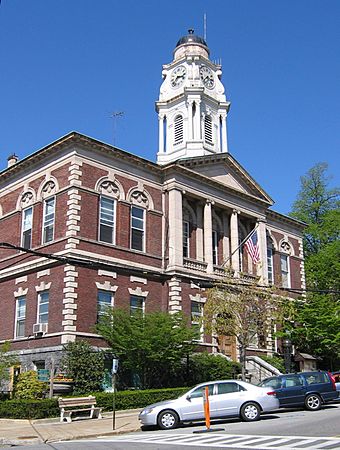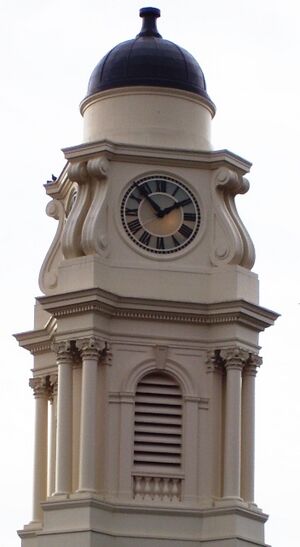Irvington Town Hall facts for kids
Quick facts for kids |
|
|
Irvington Town Hall
|
|
|
U.S. Historic district
Contributing property |
|

Front (south) elevation, 2006
|
|
| Location | Irvington, NY |
|---|---|
| Nearest city | Yonkers |
| Built | 1902 |
| Architect | Alfred J. Manning |
| Architectural style | Colonial Revival |
| Part of | Irvington Historic District (ID01300195) |
| NRHP reference No. | 84000205 |
| Added to NRHP | 1984 |
Irvington Town Hall is a special building in Irvington, New York. It is located on Main Street in the village. This building is home to the village government and the police department. It also has a public reading room. This room was part of the original agreement when the land was given for the building.
The Town Hall also has a large 432-seat theater. This theater is used for many local events. School graduations and other gatherings happen here. The building was finished in 1902. It was designed by a local architect named Albert J. Manning. He used the Colonial Revival style. This was one of the first times this style was used for a public building.
Inside, you can see beautiful glasswork and mosaics. These were made by Louis Comfort Tiffany. His father, Charles Lewis Tiffany, owned a large estate in Irvington. Because of its unique design and Tiffany's artwork, the Town Hall was added to the National Register of Historic Places in 1984. It has also been part of the Irvington Historic District since 2014.
Contents
Exploring the Town Hall's Design
The Irvington Town Hall is a two-story building made of brick. It sits on a raised basement made of stone. The outside of the building has special decorations. These include terra cotta and stone around the windows. There is also a decorative border called a cornice. The roof is a shallow hipped roof with some of its original metal.
The Clock Tower: A Village Landmark
On the front of the building, there is a beautiful porch area. It has columns and pillars that support a decorative top. Above this, there is a three-part wooden clock tower. This tower has round-arched openings and more columns. The very top of the clock tower has a dome-shaped roof. This clock tower is one of the most famous landmarks in Irvington.
The main entrance has a special arched design. Stone railings lead up to the sidewalk. The back of the building is simpler. Inside, many rooms have dark wood panels. Some rooms have wainscoting, which is wood paneling on the lower part of the walls.
Inside the Library and Theater
In the old library area, dark wood beams cross the ceiling. These beams have famous quotes written in gold leaf. The room is lit by fancy chandeliers and lanterns. These were also designed by Louis Comfort Tiffany. The walls are made of plaster, and the main area has a domed ceiling. There are also special display areas.
The theater inside the Town Hall is very grand. It has a full orchestra section and a balcony. There are private viewing booths with round openings. The stage arch also has detailed classical decorations.
History of Irvington Town Hall
The land where the Town Hall stands was first used in 1869. A group called the Mental and Moral Improvement Society built a place called the Atheneum. This building had a library. As Irvington grew, the village needed a central place for its government. In 1892, the Society gave the Atheneum property to the village. They had one condition: the village had to always keep a library and reading room in the building. They also had to build the new Town Hall within five years.
Building the New Town Hall
The village had trouble finding an architect. So, in 1897, the Society gave them five more years. Finally, Albert J. Manning, a former office manager for a New York City architect, created a design the village liked. The new Town Hall was finished and opened in 1902. This was just as the extension was ending.
Wealthy residents of the village helped pay for the building. Frederick W. Guiteau, a member of the Society, gave $10,000 to the library. Helen Gould, who grew up nearby at the Lyndhurst estate, paid for the interior decorations. This made Tiffany's beautiful work possible. The special furniture she bought is still used today.
A Center for Community Life
The new Town Hall quickly became the heart of public life in Irvington. The theater was especially popular. It hosted school graduation ceremonies, police and fire department balls, plays, and other cultural events.
Famous people also visited. Eleanor Roosevelt spoke at a Democratic rally in 1932. This was just before her husband, Franklin D. Roosevelt, was elected President. The opera singer Lillian Nordica performed there. Ted Mack even held auditions for his Original Amateur Hour show at the Town Hall.
Restoring the Theater
In the mid-1900s, the library needed more space. It took over the stairs leading to the theater. A new tower was added to the back of the building. However, after new fire safety rules came out in the 1960s, the theater no longer met the standards. It could not be used as a public space. The library used it for storage, and it started to get old.
In 1978, a group called the Irvington Town Hall Theatre Group raised money. They got $100,000, mostly from the village. This money was used to fix up the theater. They also restored old details like the light fixtures. The theater reopened in late 1981 and has been used ever since.
By the 1990s, the library needed even more space. It also had to follow the Americans with Disabilities Act. This law requires buildings to be more accessible for everyone. The library moved to another historic building, the Lord and Burnham Building. However, a reading room, called the "Tiffany Room," still remains in the Town Hall. This fulfills the promise made in the original land agreement.
See also


